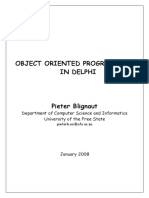0 ratings0% found this document useful (0 votes)
1 viewsteach_cs_toronto_edu_csc148h_notes_inheritance_python_special_methods_html
CSC148 Notes
Uploaded by
racayow849Copyright
© © All Rights Reserved
Available Formats
Download as PDF, TXT or read online on Scribd
0 ratings0% found this document useful (0 votes)
1 viewsteach_cs_toronto_edu_csc148h_notes_inheritance_python_special_methods_html
CSC148 Notes
Uploaded by
racayow849Copyright
© © All Rights Reserved
Available Formats
Download as PDF, TXT or read online on Scribd
You are on page 1/ 1
CSC148 Course Notes 3.
9 The object Class and Python Special
CSC148 Course Notes Methods
1. Recapping and Extending Some Now that we understand inheritance, we can gain a deeper understanding of some of Python’s fundamental special methods.
Key Prerequisite Material
1.1 The Python Memory Model:
Introduction The object superclass
1.2 The Python Memory Model: In our very first lecture, we described every piece of data as an object, and have continued to use this term throughout this
Functions and Parameters
course. It turns out that “object” is not merely a theoretical concept, but made explicit in the Python language. In Python, we
1.3 The Function Design Recipe have a class called object , which is an ancestor of every other class, both built-in classes like int or our user-defined
1.4 Preconditions classes like Employee .[1]
1.5 Python Type Annotations
2. Testing Your Code Inheriting special methods
2.1 Testing Your Work
This object class gives default implementations for many special methods we have seen before, including:
2.2 Choosing Test Cases
__init__ , which allows us to create instances of a class even when the class body is empty—it’s not magic, our classes
2.3 Code Coverage
simply inherit object.__init__ ! So every time we define __init__ within our own class, we are actually overriding
2.4 Introduction to Property-Based
object.__init__ .
Testing
__str__ , which is called when you call either str or print on an object. The default implementation? Identifying the
3. Object-Oriented Programming class name and a location in your computer’s memory:
3.1 Introduction to Object-Oriented
>>> class Donut:
Programming
... pass
3.2 Representation Invariants ...
>>> d1 = Donut()
3.3 The Class Design Recipe >>> print(d1)
<Donut object at 0x103359828>
3.4 More on Designing Classes
3.5 Inheritance: Introduction and
__eq__ , which is called when you use == to compare objects. The default object.__eq__ implementation simply uses
Methods
is to compare the two objects.
3.6 Inheritance: Attributes and
Initializers
>>> donut1 = Donut()
3.7 Inheritance: Tracing Initialization >>> donut2 = Donut()
>>> donut1 == donut2 # compares `donut1 is donut2`, which is False
3.8 Inheritance: Thoughts on Design False
>>> donut1 == donut1 # compares `donut1 is donut1`, which is True
3.9 The object Class and Python True
Special Methods
Keep in mind that even though these methods are called “special”, overriding them in your classes works in the exact same
4. Abstract Data Types
way as other methods: simply define a method with the specific name of that special method.
4.1 Introduction to Abstract Data
Types
[1] By “ancestor” we mean either a parent class, or a parent of a parent class, etc.
4.2 Stacks and Queues
4.3 Exceptions Previous Next
3.8 Inheritance: Thoughts on Design 4.1 Introduction to Abstract Data Types
4.4 Analysing Program Running
Time
By Diane Horton and David Liu
5. Exceptions © Copyright 2022.
You might also like
- Blockchain Tutorial - How To Become A Blockchain Developer - Cram Session! - BlockgeeksNo ratings yetBlockchain Tutorial - How To Become A Blockchain Developer - Cram Session! - Blockgeeks27 pages
- Descriptor Howto Guide: Guido Van Rossum and The Python Development TeamNo ratings yetDescriptor Howto Guide: Guido Van Rossum and The Python Development Team8 pages
- Descriptor Howto Guide: Guido Van Rossum and The Python Development TeamNo ratings yetDescriptor Howto Guide: Guido Van Rossum and The Python Development Team8 pages
- Introduction To Object Oriented Programming (OOP) : By: Pn. Nor Anisah Binti Mohd SaadNo ratings yetIntroduction To Object Oriented Programming (OOP) : By: Pn. Nor Anisah Binti Mohd Saad23 pages
- Descriptor Howto Guide: Guido Van Rossum and The Python Development TeamNo ratings yetDescriptor Howto Guide: Guido Van Rossum and The Python Development Team8 pages
- Assignment 1 Frontsheet Java - CompressNo ratings yetAssignment 1 Frontsheet Java - Compress31 pages
- Classes, Constructors, and Attributes - Arcade 2023 DocumentationNo ratings yetClasses, Constructors, and Attributes - Arcade 2023 Documentation17 pages
- Which One of The View of Defining Al Concerned With Thought ProcessingNo ratings yetWhich One of The View of Defining Al Concerned With Thought Processing34 pages
- Object Oriented Programming With CPP Study Material GTU 2017 21022017 023107AM100% (1)Object Oriented Programming With CPP Study Material GTU 2017 21022017 023107AM67 pages
- Classes and Methods (Cont'd) : (Some Slides Omitted or Modified.)No ratings yetClasses and Methods (Cont'd) : (Some Slides Omitted or Modified.)22 pages
- 2nd PUC - Computer Science Passing Package - YouTubeNo ratings yet2nd PUC - Computer Science Passing Package - YouTube40 pages
- Introduction to Basic Programming ConceptsNo ratings yetIntroduction to Basic Programming Concepts2 pages
- Formatting and VBA Codes For Headers and Footers - Microsoft DocsNo ratings yetFormatting and VBA Codes For Headers and Footers - Microsoft Docs3 pages
- Physics and Maths: User Experience and User Interface DesignNo ratings yetPhysics and Maths: User Experience and User Interface Design6 pages
- PG - MCA - Computer Applications - 315 14 - Data Structure Using C++ Lab - MCANo ratings yetPG - MCA - Computer Applications - 315 14 - Data Structure Using C++ Lab - MCA104 pages
- 3.4.cloud Service Model - IaaS, PaaS, SaaSNo ratings yet3.4.cloud Service Model - IaaS, PaaS, SaaS12 pages
- Wincc Oa User Days 2015 Customizing Wincc OaNo ratings yetWincc Oa User Days 2015 Customizing Wincc Oa20 pages

























































































